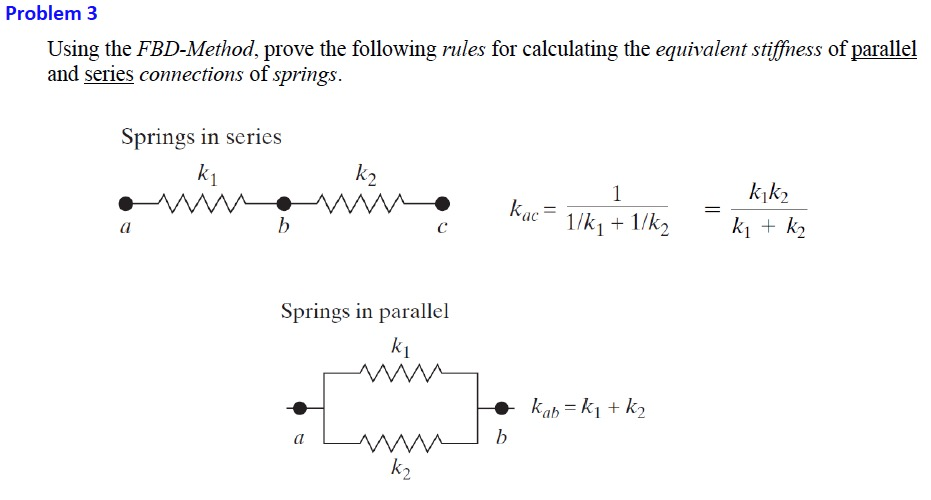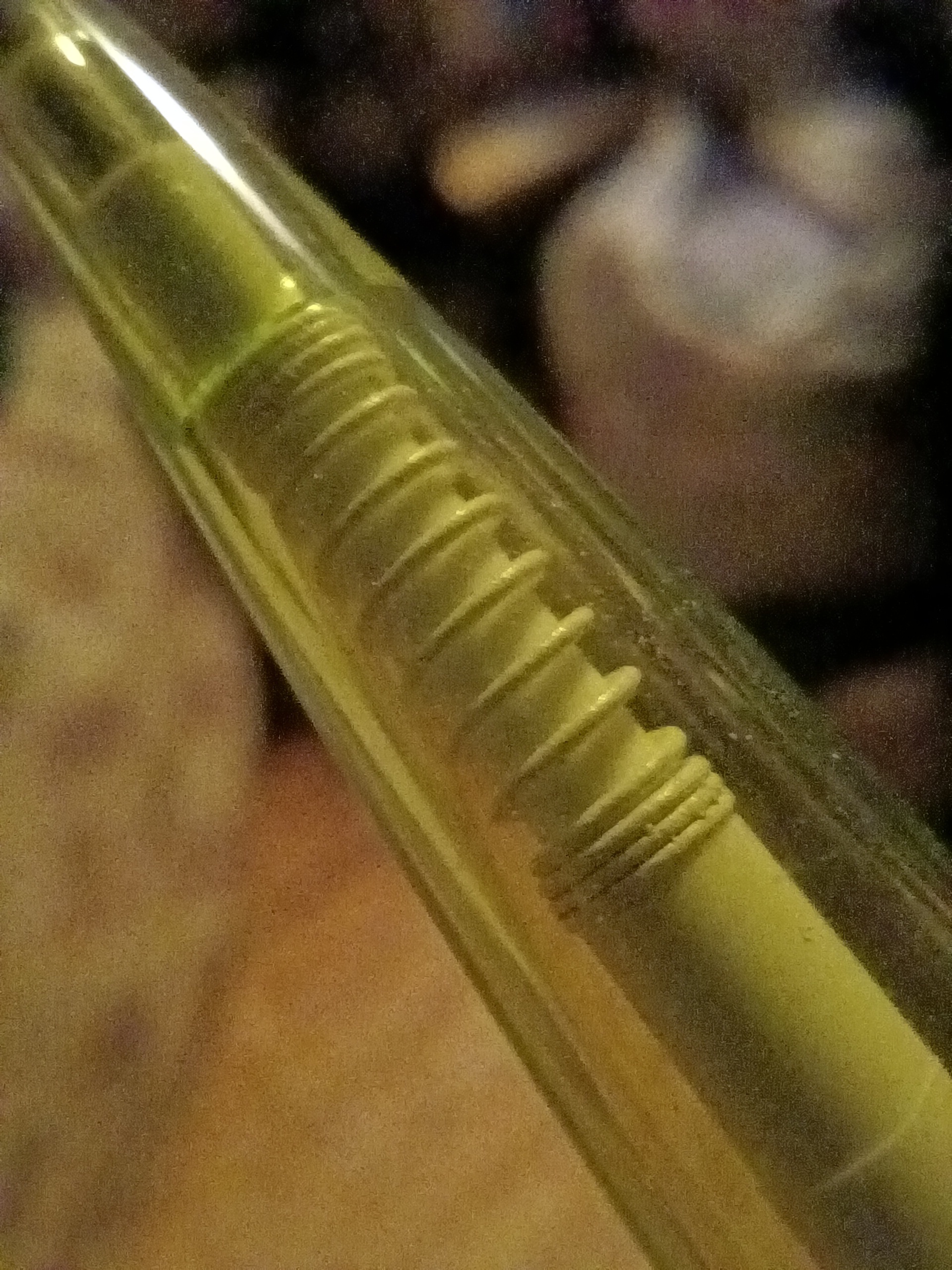First thought: Maybe it helps reduce buckling
But as others said it may behave as two springs in series, giving a different effective stiffness in the equation below

Community Rules
Rule 1: Be respectful and inclusive.
Treat others with respect, and maintain a positive atmosphere.
Rule 2: No harassment, hate speech, bigotry, or trolling.
Avoid any form of harassment, hate speech, bigotry, or offensive behavior.
Rule 3: Engage in constructive discussions.
Contribute to meaningful and constructive discussions that enhance scientific understanding.
Rule 4: No AI-generated answers.
Strictly prohibit the use of AI-generated answers. Providing answers generated by AI systems is not allowed and may result in a ban.
Rule 5: Follow guidelines and moderators' instructions.
Adhere to community guidelines and comply with instructions given by moderators.
Rule 6: Use appropriate language and tone.
Communicate using suitable language and maintain a professional and respectful tone.
Rule 7: Report violations.
Report any violations of the community rules to the moderators for appropriate action.
Rule 8: Foster a continuous learning environment.
Encourage a continuous learning environment where members can share knowledge and engage in scientific discussions.
Rule 9: Source required for answers.
Provide credible sources for answers. Failure to include a source may result in the removal of the answer to ensure information reliability.
By adhering to these rules, we create a welcoming and informative environment where science-related questions receive accurate and credible answers. Thank you for your cooperation in making the Ask Science community a valuable resource for scientific knowledge.
We retain the discretion to modify the rules as we deem necessary.
First thought: Maybe it helps reduce buckling
But as others said it may behave as two springs in series, giving a different effective stiffness in the equation below

If the coils are the same wire gauge and pitch then putting two springs in series is the same as having one spring of twice the free length.
As stated in other comments it could be:
Ones i haven't seen here which I'll posit:
This is one of my favorite models also. It will write well on thermal paper. I especially like how it'll write on wet paper, which is a big bonus if you do a lot of plumbing
Hell you might wanna look into rite in the rain being a plumber lol!
The way the spring is designed is very akin to taking two separate springs, and attaching them in series. On a highly technical level, this creates a quite different response to motion than a single spring would have. On a lower tech level, it's approximately the same as regular spring with a different stiffness value.
I'd like to think that some engineers went down the rabbit hole, doing differential equations or modal analysis to solve some complex design problem. More likely it was just a cheap or easy way to solve a manufacturing or supply problem.
Edit: Upon further reflection, spring stiffness does not care about length. The primary concerns are thumb travel (deflection) and force to click (deflection times stiffness). I suspect that deflection is pretty well set by ergonomic factors. This design would reduce the effective spring stiffness by half (and therefore the force). The most obvious other way to reduce stiffness would be reducing wire thickness, which could reduce reliability.
Noise, on the other hand, is an expected result of clicky-pens. People don't like products behaving unexpectedly. If the design made the pen quieter, you can bet they would advertise it on the packaging.
I kind of hate how much thought I've put into this.
I kind of love how much thought you’ve put into this.
I find this stuff fascinating, thank you for typing it out.
Upon further reflection, spring stiffness does not care about length.
It does. If you have two springs with the same diameter made from the same wire, but one spring has the double amount of coils, i.e. the double length, the longer spring will have half the stiffness (or the double compliance) of the shorter spring.
This design would reduce the effective spring stiffness by half (and therefore the force)
In fact it's the opposite. The "dead" coils at the end and in the centre increase the overall (compressive) striffness of the spring.
The most obvious other way to reduce stiffness would be reducing wire thickness, which could reduce reliability.
Slightly increasing (or decreasing) spring stiffness by changing the wire diameter is much harder to do, as the diameter of the wire enters the stiffness factor by the power of four ~~orders of magnitude~~, i.e. increasing the diameter from 0.4 mm to 0.5 mm increases the stiffness by factor 2.44. Thus, it's much simpler to introduce 'dead' or fewer coils in the spring to increase its stiffness when the outer geometric design properties (spring diameter and length) are given by the design of the pen.
When referring to length, a given spring does not care about total length (ignoring situations where you'll introduce buckling or other modes of loading). Changing the number of coils means you'd be using a different spring design. For a given spring design, it's the same stiffness whether it's 5mm long or 10mm. That makes the math of splitting it in series simple.
I am curious about the full impact of the dead coils (I like that term). I was treating then simply as a rigid connections, effectively splitting the spring into series, reducing the effective stiffness. Can you elaborate on how they would work to increase the stiffness?
Your explanation on the effect of diameter makes a lot of sense, especially given how tight tolerances must be at this scale. I just assumed you wouldn't want to get the spring too thin for strength reasons.
I am curious about the full impact of the dead coils (I like that term). I was treating then simply as a rigid connections, effectively splitting the spring into series, reducing the effective stiffness. Can you elaborate on how they would work to increase the stiffness?
Yes, if you think of the depicted spring with dead coils in the centre, as two springs of half length combined, they decrease the stiffness of the combined springs, as two springs in row have only half the stiffness.
My thought was starting from the opposite: A spring with the same number of coils, but equally spaced.
At its ends, the axial force onto the spring is converted into internal torque. By Hooke's law, torque and shear strain (here change of twist angle with the coordinate running along the wire) are linked. This twist causes the coiled spring to contract.
However, in the spring with the "dead" coils, this motion is limited to the free coils, as the twist of the "dead" coils is inhibited by their contact. They behave like they were rigid. Thus, there only the wire of the free coils contributes to the (compressive) stiffness of the spring, which is less than the total amount of wire, yielding into a stiffer spring.
It reduces the effective free length of the spring.
Let's just rearrange the equation for a spring at full compression:
F=-kL
k=-(F/L)
Whether you use one full length spring or two half length springs doesn't matter, the spring constant is unchanged.
By reducing the free length the "dead coils" slightly increase stiffness. They have an impact on the total force at compression.
I think in this image were looking at what, maybe 10% difference in any of those factors? For the life of me i can't imagine this matters terribly much in a pen.
I was talking about the length of the wire. You are talking about the length of the spring.
By reducing the free length the "dead coils" slightly increase stiffness. They have an impact on the total force at compression.
Yes, the part of the wire coiled up in the dead coils does not contribute to the stiffness of the spring. The stiffness if the spring is determined only by the two sections in between. This is the length L in your equation and not the total length of the spring.
I think in this image were looking at what, maybe 10% difference in any of those factors? For the life of me i can't imagine this matters terribly much in a pen.
You're probably right.
Right! But those are the same thing as number of coils is the spring length divided by a geometric constant. At free length there is no strain. At compression you reach max strain/torsion. Each coil turn, assuming all are equal, adds equally to the sum of restoring force. Looking at spring free length you're just paying attention to the summed forces of the active coils.
The dead coils contribute negligibly because they would need to impinge the neighboring wire to deform. (Relegated to pure torsion) Which i think is basically what you were saying...
This prevents spring distortion by effectively creating two shorter spring segments, probably because the pen designer wanted a longer barrel and the mechanical engineer was told to “figure it out that’s why we pay you” and the truth is I have no idea it just sounds plausible enough.
My guess too. A longer spring would have more deflection in the middle. This design could reduce that and increase the spring force.
how would it deflect when confined in a plastic cylinder?
It wouldn't much, the spring wouldn't be the exact diameter of the chamber. I could see a Japanese or German pen company over-engineering the spring this way because the cad stress analyzer shows a weakness there
no, you can clearly see from the image posted the spring is snug against the interior wall of the cylinder it's enclosed in.
Your confusing an external rib for the internal wall. I can see at least a .5mm gap
Could be that the machine they have to make springs is designed to make single length springs and they changed it up a bit to accommodate making a double-length version by only changing the cut frequency or something similar
This seems most plausible to me
The spring on its own:

Shenanigans. There's no way people's fingernails are that nicely trimmed. I call AI
Only 2 fingers when there should be 5? SHENaNiGANS!
I just have to say this is a cool photo.
It maintains better tension and will last longer. Great design honestly.

Mine doesn't. Seems like an aesthetic feature, since the pen is transparent.
I just checked a couple of my clicky pens and springs are normal
I think as a pen manufacturer you just buy bulk springs and then pull them to the desired length. In this case it's either cheaper for them or they have an excess of longer springs.
You would think that but almost nothing is sourced that way. Easier and cheaper just to have them made to your engineering specs. For my business we make all the hardware in house so we get better part quality than to use off the shelf screws/bolts.
You have your own thread rolling tools!? This is crazy, I've never heard of a company making their own hardware where COTS is available.
I work in consumer goods. Not all do it in house but many will. Even if they outsource it the supplier will still make them on demand. It's just too many parts to keep organized, much easier to get what you need made and deliver it with the other parts during assembly. My company manufacturers around 1mil products a year, individual parts adds up to 10s of millions. We are just a small-mid size producer too
I guess unit cost is going to be pretty levelled at those quantities...
I've only really worked with smaller batches so it's just a bit of a shocking concept.
If you can find another pen of the same type, you could see whether it's consistent. My guess is that the spring "stuck" in that spot when they pulled/set it.
If not, it could be a noise thing.